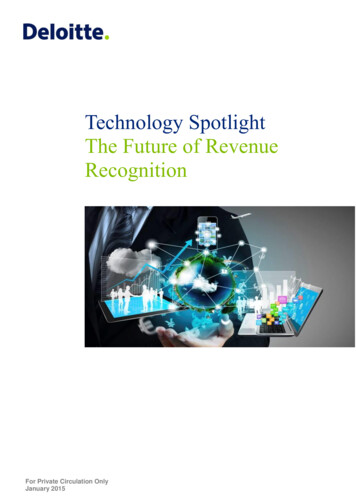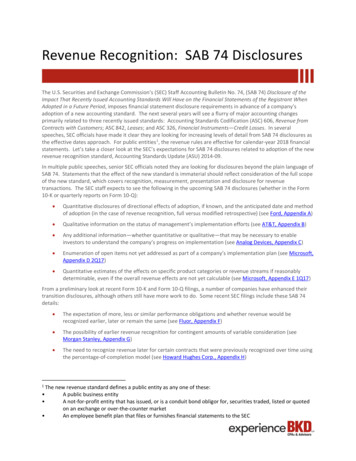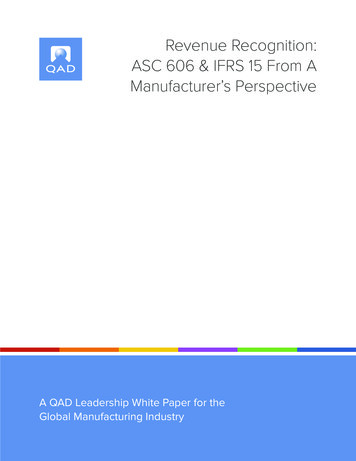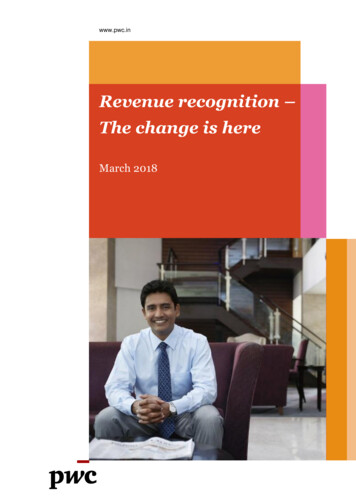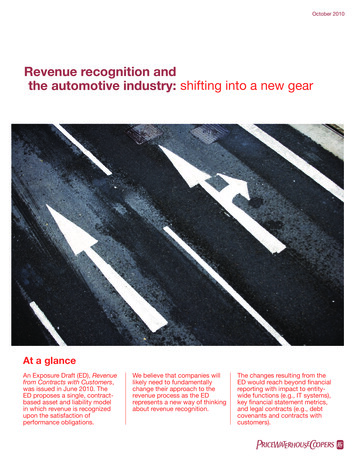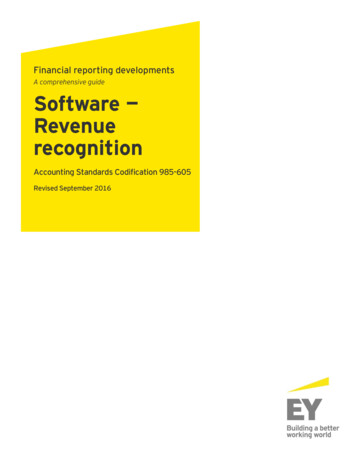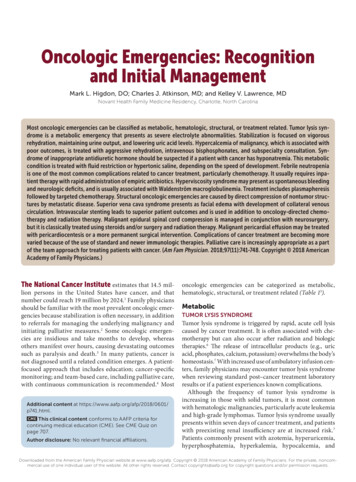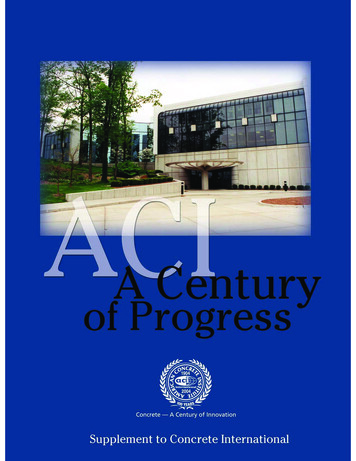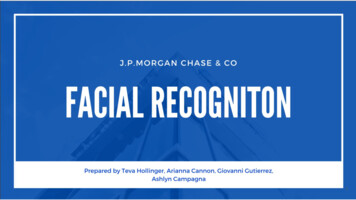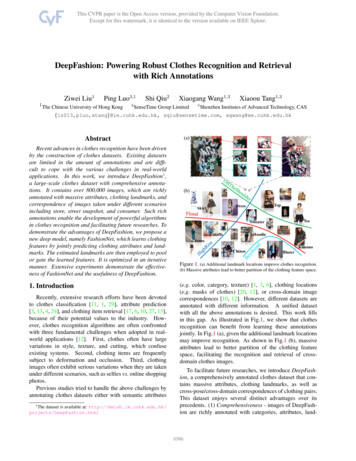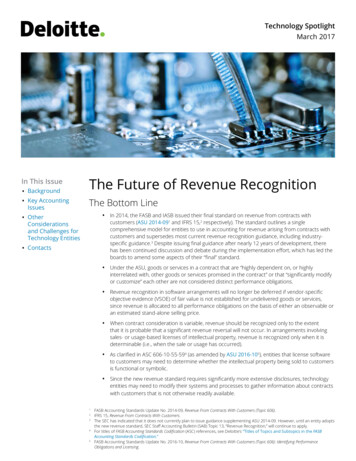
Transcription
Technology SpotlightMarch 2017In This Issue Background OtherConsiderationsand Challenges forTechnology Entities Key AccountingIssuesThe Future of Revenue RecognitionThe Bottom Line In 2014, the FASB and IASB issued their final standard on revenue from contracts withcustomers (ASU 2014-091 and IFRS 15,2 respectively). The standard outlines a singlecomprehensive model for entities to use in accounting for revenue arising from contracts withcustomers and supersedes most current revenue recognition guidance, including industryspecific guidance.3 Despite issuing final guidance after nearly 12 years of development, therehas been continued discussion and debate during the implementation effort, which has led theboards to amend some aspects of their “final” standard.Contacts 12345Under the ASU, goods or services in a contract that are “highly dependent on, or highlyinterrelated with, other goods or services promised in the contract” or that “significantly modifyor customize” each other are not considered distinct performance obligations.Revenue recognition in software arrangements will no longer be deferred if vendor-specificobjective evidence (VSOE) of fair value is not established for undelivered goods or services,since revenue is allocated to all performance obligations on the basis of either an observable oran estimated stand-alone selling price.When contract consideration is variable, revenue should be recognized only to the extentthat it is probable that a significant revenue reversal will not occur. In arrangements involvingsales- or usage-based licenses of intellectual property, revenue is recognized only when it isdeterminable (i.e., when the sale or usage has occurred).As clarified in ASC 606-10-55-594 (as amended by ASU 2016-105), entities that license softwareto customers may need to determine whether the intellectual property being sold to customersis functional or symbolic.Since the new revenue standard requires significantly more extensive disclosures, technologyentities may need to modify their systems and processes to gather information about contractswith customers that is not otherwise readily available.FASB Accounting Standards Update No. 2014-09, Revenue From Contracts With Customers (Topic 606).IFRS 15, Revenue From Contracts With Customers.The SEC has indicated that it does not currently plan to issue guidance supplementing ASU 2014-09. However, until an entity adoptsthe new revenue standard, SEC Staff Accounting Bulletin (SAB) Topic 13, “Revenue Recognition,” will continue to apply.For titles of FASB Accounting Standards Codification (ASC) references, see Deloitte’s “Titles of Topics and Subtopics in the FASBAccounting Standards Codification.”FASB Accounting Standards Update No. 2016-10, Revenue From Contracts With Customers (Topic 606): Identifying PerformanceObligations and Licensing.
Beyond the Bottom LineThis Technology Spotlight discusses the framework of the new revenue model and highlightskey accounting issues and potential challenges for technology entities that account forrevenue recognition under U.S. GAAP. For additional information about the new revenuestandard, see Deloitte’s A Roadmap to Applying the New Revenue Recognition Standard.BackgroundThe goals of ASU 2014-09 are to clarify and converge the revenue recognition principlesunder U.S. GAAP and IFRSs while (1) streamlining, and removing inconsistencies from, revenuerecognition requirements; (2) providing “a more robust framework for addressing revenueissues”; (3) making revenue recognition practices more comparable; and (4) increasing theusefulness of disclosures. The ASU states that the core principle for revenue recognition isthat an “entity shall recognize revenue to depict the transfer of promised goods or servicesto customers in an amount that reflects the consideration to which the entity expects to beentitled in exchange for those goods or services.”The ASU indicates that an entity should perform the following five steps in recognizingrevenue: “Identify the contract(s) with a customer” (step 1).“Identify the performance obligations in the contract” (step 2).“Determine the transaction price” (step 3).“Allocate the transaction price to the performance obligations in the contract” (step 4).“Recognize revenue when (or as) the entity satisfies a performance obligation” (step 5).Thinking It ThroughAs a result of the ASU, entities will need to comprehensively reassess their currentrevenue accounting and determine whether changes are necessary. In addition,among other things, the ASU requires significantly expanded disclosures aboutrevenue recognition, including both quantitative and qualitative information about(1) the amount, timing, and uncertainty of revenue (and related cash flows) fromcontracts with customers; (2) the judgment, and changes in judgment, used inapplying the revenue model; and (3) the assets recognized from costs to obtain orfulfill a contract with a customer.Key Accounting IssuesStep 1 — Identifying the Contract With a CustomerA contract can be written, verbal, or implied; however, the ASU applies to a contract only if allthe following criteria are met: “The parties to the contract have approved the contract (in writing, orally, or inaccordance with other customary business practices) and are committed to performtheir respective obligations.” “The entity can identify each party’s rights regarding the goods or services to betransferred.” “The entity can identify the payment terms for the goods or services to be transferred.”“The contract has commercial substance (that is, the risk, timing, or amount of theentity’s future cash flows is expected to change as a result of the contract).”2
“It is probable that the entity will collect substantially all of the consideration to whichit will be entitled in exchange for the goods or services that will be transferred to thecustomer.”6If a contract does not meet these criteria at contract inception, an entity must continue toreassess the criteria to determine whether they are subsequently met.Thinking It ThroughAlthough technology entities may currently consider certain of these criteria whendetermining whether persuasive evidence of an arrangement exists under ASC985-605-25 or SAB Topic 13.A (codified in ASC 605-10-S99-1), contracts that arecurrently accounted for under ASC 985-605 or ASC 605 may not be within the scopeof the ASU unless all the requirements mentioned above are met. That is, until acontract with the customer exists, the arrangement cannot be accounted for inaccordance with the ASU.CollectibilityThe ASU establishes (in ASC 606-10-25-1(e)) a collectibility threshold under which an entitymust determine whether “[i]t is probable that the entity will collect substantially all of theconsideration to which it will be entitled.” If the threshold is not met, the entity is precludedfrom applying the remaining steps in the ASU and recognizing revenue until it is probable7 thatthe consideration will be collected. Any amounts received before collectibility is consideredprobable would be recorded as revenue only if any of the following events, as outlined in ASC606-10-25-7, have occurred: “The entity has no remaining obligations to transfer goods or services to the customer,and all, or substantially all, of the consideration promised by the customer has beenreceived by the entity and is nonrefundable.” “The contract has been terminated, and the consideration received from the customeris nonrefundable.” “The entity has transferred control of the goods or services to which the considerationthat has been received relates, the entity has stopped transferring goods or servicesto the customer (if applicable) and has no obligation under the contract to transferadditional goods or services, and the consideration received from the customer isnonrefundable.”For contracts that have a variable sales price (including price concessions), entities wouldfirst estimate the consideration due under the contract (see Step 3 — Determining theTransaction Price below) and would then apply the collectibility threshold to the estimatedtransaction price.Thinking It ThroughWhile the probability threshold is unchanged from current U.S. GAAP, thisrequirement may change current practice. Technology entities typically assesscollectibility under SAB Topic 13.A or ASC 985-605 and defer revenue recognitionuntil cash is received. The new revenue standard could potentially require furtherdeferral even when nonrefundable cash has been received.67In assessing whether it is probable that the entity will collect the consideration, an entity would consider only the customer’s abilityand intention to pay that amount of consideration when it is due. The amount of consideration evaluated may be less than the pricestated in the contract if the consideration is variable because the entity may offer price concessions (see Step 3 — Determining theTransaction Price).Under U.S. GAAP, “probable” refers to a “future event or events [that] are likely to occur.” This threshold is considered higher than“probable” as used in IFRSs, under which the term means “more likely than not.”3
In certain cases (e.g., when the contract is with a financially stressed customer),entities may be unable to assert that the collectibility of the total estimatedtransaction price is probable. In such situations, the contract would not beaccounted for under the ASU’s remaining steps until collectibility is probable. Asmentioned above, any amounts that are received before the probability thresholdis met would usually be recorded as a liability unless the events listed in the bulletsabove have occurred.In other words, collectibility is assessed on the basis of the amount to which theentity will be entitled in exchange for the goods or services that will transfer tothe customer (i.e., not goods or services that will not transfer if the customer failsto pay). In addition, a contract is considered terminated if the entity has stoppedtransferring additional goods or services to the customer with no further obligationto the customer. This is particularly relevant for software-as-a-service (SaaS) vendorsthat bill customers on a monthly basis and have a customary business practice tolimit credit risk by not transferring further services upon payment delinquency.Contract CombinationAlthough entities would most likely apply the ASU to a single contract, in certain circumstancesthey may be required to combine a group of contracts and evaluate them as if they were asingle contract. Under the ASU, an entity must combine contracts entered into at or near thesame time with the same customer (or related parties of the customer) if one or more of thefollowing criteria are met: “The contracts are negotiated as a package with a single commercial objective.” “The goods or services promised in the contracts (or some goods or services promisedin each of the contracts) are a single performance obligation [as defined].”“The amount of consideration to be paid in one contract depends on the price orperformance of the other contract.”Thinking It ThroughSince technology entities commonly enter into multiple agreements with the samecustomer within a short period, they need to consider whether certain contractsshould be combined for revenue recognition purposes. Although the contractcombination requirements mentioned above are similar to certain aspects ofexisting guidance (such as the factors listed in ASC 985-605-55-4 for softwarearrangements), entities may need to reevaluate their conclusions under the ASU todetermine whether changes in contract combinations may be necessary.Contract ModificationsThe ASU also provides guidance on accounting for “approved” modifications to contractswith customers. The approval of a contract modification can be in writing, by oral agreement,or implied by customary business practices, and a contract modification is consideredapproved when it creates new or changes existing enforceable rights or obligations. A contractmodification must be accounted for as a separate contract when (1) it results in a changein contract scope because of additional promised “distinct” goods or services (see Step 2 —Identifying Separate Performance Obligations in a Contract below) and (2) the additionalconsideration reflects the entity’s stand-alone selling price of those additional promisedgoods or services (including any appropriate adjustments to reflect the circumstances of the4
contract). If an entity determines that the modification is not a separate contract, the entitywould, depending on the specific facts and circumstances of the modified contract (as definedin the ASU), apply one of the following methods: Treatment as a termination of the existing contract and creation of a new contract(prospective method) — If the remaining goods or services are distinct from thegoods or services transferred on or before the date of the contract modification, theremaining transaction price8 and any additional consideration promised as a resultof the modification are allocated to the remaining performance obligations in themodified contract. Cumulative catch-up adjustment (retrospective method) — If the remaining goods orservices are not distinct and are part of a single performance obligation that is partiallysatisfied as of the date of the contract modification, the performance obligation’smeasure of progress toward completion is updated, which may result in a cumulativecatch-up of revenue. A combination of these two methods (if both of the above conditions exist).Thinking It ThroughTechnology entities often enter into agreements that may amend, cancel, terminateor otherwise change the provisions of the master or original agreement (oftenreferred to as side agreements). These entities may need to apply judgment indetermining whether these agreements represent approved modifications andwhether each modification should be accounted for as a separate contract or dealtwith under the prospective or retrospective methods outlined above. In eithercase, accounting for modifications under the ASU may change the manner in whichentities currently account for such amendments under existing U.S. GAAP.Further, when additional goods or services are priced at a discount, a technologycompany should evaluate why the discount was given. If some or all of the discountis effectively a price concession for goods or services already delivered, suchconcession might need to be immediately recorded to revenue as an adjustment tothe transaction price. Refer to Example 5, Case B,9 of the ASU.Step 2 — Identifying Separate Performance Obligations in a ContractASU 2014-09 provides guidance on evaluating the promised “goods or services”10 in a contractto determine each performance obligation (i.e., the unit of account). Performance obligationsrepresent each promise to transfer either of the following to a customer: 891011“A good or service (or a bundle of goods or services) that is distinct.”“A series of distinct goods or services that are substantially the same and that havethe same pattern of transfer to the customer.”11Under the revenue model, the transaction price available for allocation would include the “consideration promised by the customer(including amounts already received from the customer) that was included in the estimate of the transaction price and that had notbeen recognized as revenue.”ASC 606-10-55-114 through 55-116.Although the ASU does not define goods or services, it includes several examples, such as goods produced (purchased) for sale(resale), granting a license, and performing contractually agreed-upon tasks.A series of distinct goods or services has the same pattern of transfer if both of the following criteria are met: (1) each distinct goodor service in the series would meet the criteria for recognition over time and (2) the same measure of progress would be used todepict performance in the contract.5
A promised good or service is distinct (and therefore a performance obligation) if both of thefollowing criteria are met: Capable of being distinct — “The customer can benefit from the good or service eitheron its own or together with other resources that are readily available to the customer.” Distinct in the context of the contract — “The entity’s promise to transfer the good orservice to the customer is separately identifiable from other promises in the contract.”The ASU (as amended by ASU 2016-10) provides the following indicators for evaluatingwhether a promised good or service is not separable from other promises in acontract:o“The entity provides a significant service of integrating goods or services with othergoods or services promised in the contract . . . . In other words, the entity is usingthe goods or services as inputs to produce or deliver the combined output oroutputs specified by the customer.”o“One or more of the goods or services significantly modifies or customizes, or aresignificantly modified or customized by, one or more of the other goods or servicespromised in the contract.”o“The goods or services are highly interdependent or highly interrelated. In otherwords, each of the goods or services is significantly affected by one or more ofthe other goods or services in the contract. For example, in some cases, two ormore goods or services are significantly affected by each other because the entitywould not be able to fulfill its promise by transferring each of the goods or servicesindependently.”Stand-Alone Value Requirements Under ASC 605-25Currently, multiple-element software arrangements that are not within the scope of ASC985-605 or ASC 605-3512 (e.g., certain types of hosted software and data arrangements) aretypically accounted for under ASC 605-25. Under ASC 605-25-25-5, deliverables in multipleelement arrangements are treated as separate units of account if the delivered items havevalue to the customer on a stand-alone basis (a determination that involves an assessmentof whether the deliverables are sold separately by any vendor or the customer could resellthe delivered items on a stand-alone basis). Under the ASU, in evaluating whether a good orservice is a separate performance obligation, entities need to consider whether the good orservice is capable of being distinct and distinct within the context of the contract, as describedabove.Thinking It ThroughThe ASU’s guidance on determining whether a customer can benefit from a good orservice on its own, or with other readily available resources, is generally consistentwith the current guidance in ASC 605-25 on determining whether a good or servicehas stand-alone value. The ASU states that “the fact that the entity regularly sells agood or service separately would indicate that a customer can benefit from the goodor service.”12Formerly AICPA Statement of Position 81-1, Accounting for Performance of Construction-Type and Certain Production-Type Contracts.6
The requirement that the promise to transfer a good or service be “separatelyidentifiable from other promises in the contract” is a new concept under whichentities must further evaluate a good or service for separability. Entities may needto use significant judgment when determining whether the goods or services ina contract are “highly dependent on, or highly interrelated with, other goods orservices promised in the contract” or whether they “significantly modify or customize”each other. In such circumstances, entities may need to account for a bundle ofgoods or services, which may qualify for separate accounting under current U.S.GAAP, as a single performance obligation (unit of account).Example 1113 of the ASU presents two cases that illustrate how technology entitieswould determine whether goods or services in a software arrangement are distinct.Each case depicts a typical software arrangement involving a license, an installationservice, software updates, and technical support. In Case A, the installation
985-605-25 or SAB Topic 13.A (codified in ASC 605-10-S99-1), contracts that are currently accounted for under ASC 985-605 or ASC 605 may not be within the scope of the
